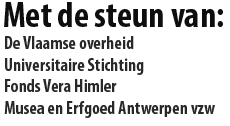B. DE CREMER
Volksgeneeskunde nu: een evaluatie van alternatieve geneeswijzen als volwaardige aanvulling of tegenhanger van reguliere geneeskunde
Summary : In 1996-1997 the study group “Popular Medicine” of Leuven University, developed and distributed inquiry forms in order to investigate the medical consumption, based on 100 inquiry forms related to the village of Wilsele in Flemish Brabant, the author tries to work out the relation between traditional and alternative therapies in 50 theymatic and migraine patients. On this study the author concludes that most of the patient/consulers still prefer classical medicine to alternative medicine, and that popular medicine is mostly considered to be additional as a second help. However, these non-official ways of curing obtain a more and more greater place in the medical treatment and healing process.
In the long term, there may arise a keen competition between popular and classical medicine.
,
I. PEERE
Chants populaires flamands (1879) als wetenschappelijke getuigenis van een vroeg individueel repertoire: een voorstudie
Summary : this article is the summary of a lecture given on the 29th conference of the Kommission für Volksdichtung in Aberdeen in August 1999. The author tests the existing context literature on the well-known folk song collection ‘Chants Populaires Flamands avec les airs notés et poésies populaires diverses recueillis à Bruges’ by Ad.-R. Lootens and J.M.E. Feys with novel data and on the basis of these, she sets up some new hypotheses. The writer proves that Lootens and Feys might have been relatives and that Catherine Beyaert, Lootens ’s mother was, most likely, the most important source of Lootens’s fielswork. Moreover, she casts a new light on the collaboration between Lootens and Feys during the realization of the manuscript.
,
P. PEETERS
Uit de archieven van K.C. Peeters – De Werkgemeenschap voor Heemkunde
Summary : The ‘Werkgemeenschap voor Heemkunde’ (‘Study Team for Local History an d Folklore’), predecessor of the present ‘Verbond voor Heemkunde’ (‘Association of Local History and Customs) worked from 6th May 1939 till 22th March 1941, officially that is. Apart from the texts, published by the founders of the Study Team, very few articles about it have been written or published. In addition to this, data of the K.C. Peeters’s archives demonstrate that some authors misinterpreted the events that took place then.
This article aims at supplementing the data of the ‘Werkgemeenschap voor Heemkunde’ by giving additional genuine and authentic data, publications and studies and at correcting some older material.
In particular, more light is thrown on the relationship of the Study Team with Davidsfonds (Flemish Catholic Organisation, founded in 1875) and the real causes that led to the dissolution of the ‘Work Team’ are brought into the open.
,
W.L. BRAEKMAN
IJspret te Antwerpen in de Winter van 1564 en van 1763
Summary : In an earlier contribution by the same author, fun on the ice and snow sculptures in Antwerp in the 17th and 18th centuries were discussed in detail. Starting from a woodcut, and especially from an anonymous market song, he now evokes fun on the ice on the river Scheldt in 1564 and 1763. The unique market song, dated 1763, is kept in the library of the “Oudheidkundige Kring van het Land van Waas” (Archeological Circle of the Land of Waas). The present article also includes an unabridged edition of the text with comments.
,

